This website uses cookies so that we can provide you with the best user experience possible. Cookie information is stored in your browser and performs functions such as recognising you when you return to our website and helping our team to understand which sections of the website you find most interesting and useful.
Cosme Palacio: championing Laguardia
At a tasting of Cosme Palacio, Entrecanales Domecq e Hijos head winemaker Almudena Alberca MW celebrated the unique terroir of Laguardia in Rioja Alavesa.

Alberca, who has been with Entrecanales since 2015, said: “I always wanted to work in Rioja…you can show what you are able to do there.”
Cosme Palacio has provided her with the opportunity to continue the legacy of Michel Rolland, who joined as a consultant in the late 1980s. “We are keeping a lot of the historic philosophy that this winery used to have…It was the winery that created the new Rioja styles of the present,” she said.
The hallmarks of these new styles have been separate vinificiation of each vineyard to increase blending potential, ageing in new French oak, and longer maceration times. Today, French oak constitutes a high proportion of the 12,000 barrels held in Cosme Palacio’s cellar in Laguardia.
But, while thinking ahead is key, old vines have proven to be a great asset. Cosme Palacio is the owner of one of the few ‘Singular Vineyards’ where 100-year-old vines grow in a ravine facing the Sierra de Cantabria. In total, just 150 of the 60,000 hectares under vine in DOCa Rioja are ‘Singular Vineyards’, recognised for their distinctive character.
Alberca believes that Laguardia having a less continental, more Mediterranean climate is a major advantage for Tempranillo cultivation, as is the average annual rainfall of 500ml (as opposed to 300-350ml in Ribera del Duero): “Tempranillo stresses very easily when you have drought, it’s a sensitive variety”.
While south-facing, the higher altitude of Laguardia does help the grapes to retain freshness.
Partner Content

However, Tempranillo is not the be-all and end-all for Cosme Palacio’s reds: “There will be more varieties in the coming years…we are finding beautiful Graciano to blend”.
The calcareous clay soil of Rioja Alavesa leaves a distinct impression on its wines, as Alberca explains: “There is something very unique in Laguardia village…we are always going to find a very strong strawberry character, and a bit of limestone on the palate.”
By contrast, the regions south of the River Ebro, Rioja Alta and Rioja Baja, have more ferrous clay and alluvial soil.
Of the lineup on show that day, which included 2018 Vino de Laguardia and 2015 Viñedos Viejos Reserva, as well as white wines, Alberca singled out the 2017 vintage of the 1894 Tinto for its intensity and character. Macerated for at least 28 days, and aged for at least 15 months in 500 litre French oak, ‘1894’ refers to the year of Cosme Palacio’s foundation: “For me, this wine represents the potential of Tempranillo in Laguardia”.
Indeed, Cosme Palacio’s plans for the future do seem centred on expanding the area of old vines it possesses in Laguardia. “We own 20ha in Laguardia – we are still looking for more,” explained Alberca. “Between last year and this year, we bought 8ha of more than 35 years of age.”
Earlier this year, Entrecanales Domecq e Hijos gained Carbon neutral certification.
Related news
Torres Brandy to host Zero Challenge final in Barcelona





